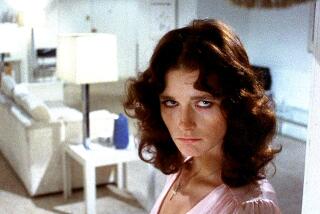‘Dial M’: Hitchcock With a Killer Scene
- Share via
If we believe Alfred Hitchcock, his “Dial M for Murder” is a production-line film he could have “phoned in.” To meet a studio commitment, he took only 36 days to shoot it, all but a half-dozen shots on the same set.
“There isn’t very much we can say about that one, is there?” he told interviewer and fellow director Francois Truffaut. “I just did my job, using cinematic means to narrate a story taken from a stage play.”
Right. And wine is just spoiled grape juice.
When a ceremony was staged at Lincoln Center in 1974 to honor Hitchcock, and he was called to the stage, the program directors chose the most memorable scene from “Dial M” to project for the audience. In it, a hired killer tries to strangle the heroine in her own apartment, but instead the killer is killed. “As you can see,” Hitchcock quipped, “the best way to do it is with scissors.”
You can see what he was talking about Friday when “Dial M” opens a week’s run at the Block in Orange, one in the theater’s Warner Bros. Classics series.
In 1953, Hitchcock owed Warner Brothers a film, and the script he was developing was progressing poorly. He decided to make a film version of the Frederick Knott play, shortening it and using much of the same dialogue.
It was Hitchcock’s first film starring Grace Kelly, and he was so pleased with her he cast her in his next two movies (“Rear Window” and “To Catch a Thief”). The only other actress who starred in as many Hitchcock films was Ingrid Bergman.
It was also Hitchcock’s first--and only--experiment with 3-D, which was hot at the time but about to rapidly decline in audience popularity. Its novelty was wearing thin. Directors used it almost entirely for shock value, propelling objects toward the camera so they would appear to be shooting into the audience.
In “Dial M,” Hitchcock used 3-D to much better effect. Grace Kelly, attacked from behind and flung onto a desk, flails her arm about, trying to reach a pair of scissors. In 3-D, her arm seems to reach from the screen to the audience as if appealing for help.
She finds the scissors, and as her attacker bends over her, she stabs him. He falls backward, driving the scissors farther into his body.
“With the shower sequence in ‘Psycho’ and the rape-strangling scene in ‘Frenzy,’ this is one of the few visually revolting moments in Hitchcock’s films,” wrote film historian Donald Spoto.
You won’t be seeing the 3-D version at the Block. Even when the film was first released, most theaters showed the flat version.
And if you are a Hitchcock spotter and don’t want to be tipped off, don’t read the rest of this paragraph. (He’s at the left in a reunion photograph shown 13 minutes into the film.)
* ‘Dial M for Murder,” 1954. Running time: 1 hour, 45 minutes. AMC 30 at the Block, The City Drive, Orange. Opens Friday.
Bertolucci’s Poignant ‘Before the Revolution’
Bernardo Bertolucci, considered by some to be the best Italian director of his generation, made his mark at age 24 with the 1962 film “Prima della rivoluzione” (“Before the Revolution”), which depicted a young man leaning toward Marxism and tortured by his bourgeois origins.
The film will be shown Friday by the UCI Film Society.
“Prima” was, according to Times movie critic Kevin Thomas, “as bold and emphatic an announcement that a major director has arrived as has ever been made. Bertolucci brings a profound poignancy to a young man’s painful discovery of self by showing that his growing awareness of his own limitations is equaled by his recognition of the vast possibilities of life.”
* “Prima della rivoluzione,” 1962. Running time: 1 hour, 45 minutes. Crystal Cove Auditorium, UCI Student Center, 7 p.m. and 9 p.m., Friday, Jan. 29. Admission: $4.50 to $2.50.
Challenging the Role of Home Video
“Kelly Loves Tony,” tonight’s episode in the UCI Film and Video Center’s “Third Eye” series on race, is unusual, to say the least.
Director Spencer Nakasako, wanting to portray the struggles of a young Laotian couple’s out-of-wedlock pregnancy in Oakland, simply gave them a home video camera and told them to use it. The result was broadcast as part of PBS’ independent film series “P.O.V.”
Opinion is divided on the film’s success. The Film and Video Center’s program describes “Kelly Loves Tony” as “a moving story, and a wonderful example of how great films can be made by any means necessary, even with a hi-8 [video] camera.”
But the Boston Globe criticized Nakasako’s approach as having “almost overwhelming disadvantages,” such as the distraction of jarringly amateurish camera work and the limitation that one of the stars must always be off-screen operating the camera.
* “Kelly Loves Tony,” 1997. Running time: 1 hour. UCI Humanities Instruction Building, Room 100, 7 p.m. today. Admission: $6 to $4.
More to Read
Only good movies
Get the Indie Focus newsletter, Mark Olsen's weekly guide to the world of cinema.
You may occasionally receive promotional content from the Los Angeles Times.








